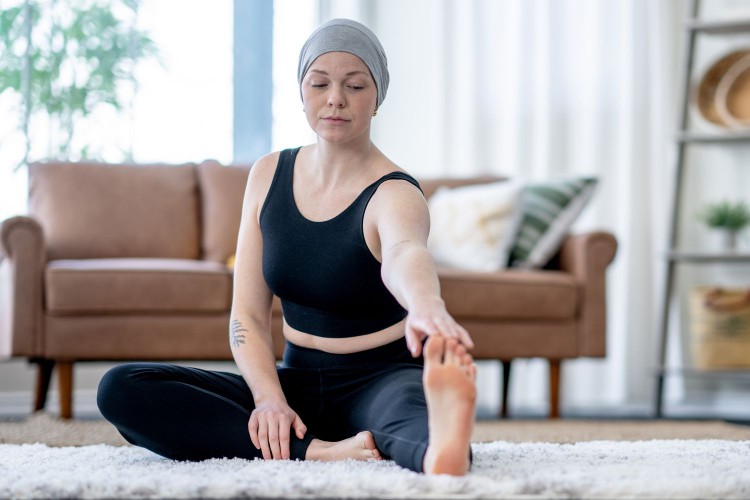People With Stage IV Breast Cancer May Benefit From Exercise, Study Finds
- New research found that regular exercise can help improve common symptoms of cancer treatment with advanced-stage breast cancer.
- After nine months of an exercise routine that combined cardio and strength training, patients reported a better quality of life and less fatigue.
- Experts recommend breast cancer patients review any new exercise routine with a trusted medical professional who understands their unique health needs.
Women being treated for metastatic breast cancer may experience relief from fatigue and improved quality of life overall through exercise, a new study finds.
Past research has concluded that exercise is both feasible and beneficial for people undergoing treatment for earlier-stage breast cancer.
But, “there has been a lack of research done in people with advanced breast cancer,” said Jennifer Ligibel, MD, director of the Zakim Center for Integrative Therapies at the Dana-Farber Cancer Institute in Boston.
Some studies have proven reason for concern over whether people with metastatic cancer would be able to exercise because of the advanced stage and spread of their cancer.
But “this study helps to confirm that exercise is feasible for patients with metastatic cancer,” Neil Iyengar, MD, a breast cancer and exercise oncologist at Memorial Sloan Kettering Cancer Center, told Health.
Here’s how exercise may improve the lives of breast cancer patients, as well as doctor-recommended exercises these patients can try.

Getty Images / FatCamera
Stage IV Cancer Patients Saw Increased Quality of Life With Exercise
Treatment for metastatic—stage IV—breast cancer typically lasts longer than breast cancer in earlier stages, which makes improving quality of life during treatment particularly important for these patients, Anne May, PhD, who is leading the new research, told Health.
If the type of metastatic breast cancer a person has is hormone-responsive, the first line of treatment is hormone therapy, which may be combined with a targeted cancer drug.
For types that are not hormone-responsive, chemotherapy, usually a combination of multiple drugs, is used.
The new study set out to determine whether a prescribed exercise regime could relieve some common side effects of these treatments, including fatigue, nausea, pain, and shortness of breath.
May, who is also a professor at the Julius Center for Health Sciences and Primary Care at the University Medical Center, Utrecht, in the Netherlands, presented the early results of the ongoing trial at the San Antonio Breast Cancer Symposium in early December.
So far, the clinical trial, which is based in Europe, includes nearly 360 people with metastatic breast cancer. About 180 of these patients took part in a planned twice-a-week exercise program that included a mix of aerobic and strength training.
All sessions were supervised by a physiotherapist or other exercise expert, and most workouts occurred in group settings, though occasionally people were guided during one-on-one sessions.
Ligibel noted that a strength of the study was the fact that women were undergoing a variety of different treatments, including both hormone and chemotherapy.
After three, six, and nine months, both groups filled out questionnaires that gauged their physical, mental, emotional, and financial quality of life, as well as how fatigued they felt on a day-to-day basis.
The researchers also tested their physical fitness, asking participants to ride on a stationary bike with increasing resistance until they felt they needed to stop.
Compared to those who did not participate in the exercise program, participants who did reported less fatigue. They also reported having a higher perception of their overall quality of life, as well as improved pain.
This group’s strength improved, too.
After six months, participants in the exercise group could ride a stationary bike with a 13% higher resistance level than those in the control group. Many of these patients continued with their routine after the nine months were up.
The results have not yet been published in a peer-reviewed journal, and more research needs to be done to determine exactly how exercise might relieve cancer treatment side effects, but Iyengar said the results are on par with what previous trials have shown for exercise in people with less advanced stages of breast cancer.
By improving cardiopulmonary fitness—both cardiovascular and respiratory stamina—exercise can improve fatigue.
“There is also certainly a cognitive component,” Iyengar said. “We know exercise improves mood, memory, and cognitive functioning.”
Metastatic Breast Cancer Treatments
Doctor-Recommended Exercises For Stage IV Breast Cancer
May recommends people undergoing treatment for metastatic breast cancer to talk with their doctors before starting an exercise routine.
Movement should be individualized, based on a person’s physical fitness as well as their side effect—this is best done with the supervision of a trusted healthcare provider.
“Any physical activity is better than none,” May said, though in general, intense exercise usually yields more benefits.
According to Ligibel, strength training can be particularly important since it’s common for people to lose some muscle mass while undergoing cancer therapy.
“Strength training can take a lot of different forms; you don’t need weights,” she explained. “Doing core exercise and using your own body weight is exercise meant to strengthen your muscles.”
In addition to strength training, cardio can provide benefits to cancer patients, like relieving fatigue, Iyengar said.
If fatigue increases after exercising regularly, people should speak with their physician about ways they can adjust their workouts, May added.
Movements, whether cardio or strength training, can be tailored to accommodate cancer side effects such as the loss of movement in a limb, issues with balance, or neuropathy, Iyengar said.
Again, any new movement strategy should be discussed with a medical professional.
“A lot of people will have bone metastasis, and evidence has shown that exercise is safe for these people, but there are considerations such as where the metastatic lesions are and where you are putting weight,” Ligibel said. “That warrants a talk with someone in the medical setting.”
How Moving More and Sitting Less May Help Lower Breast Cancer Risk










